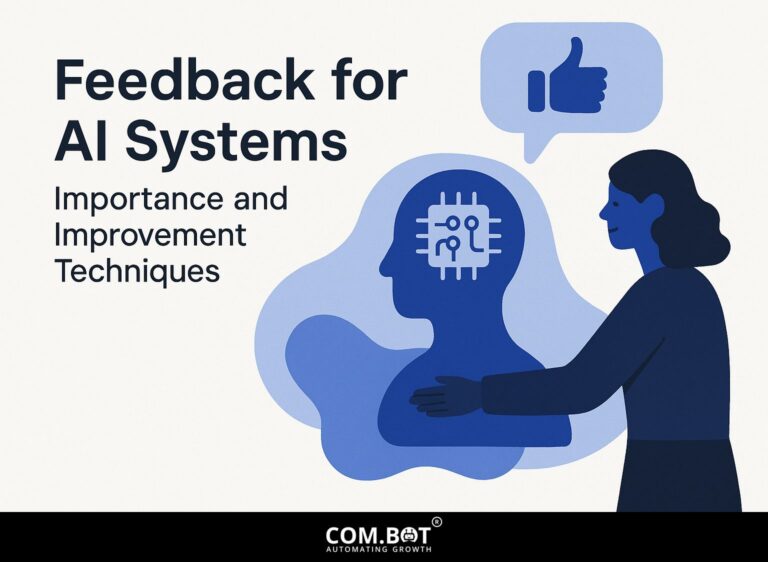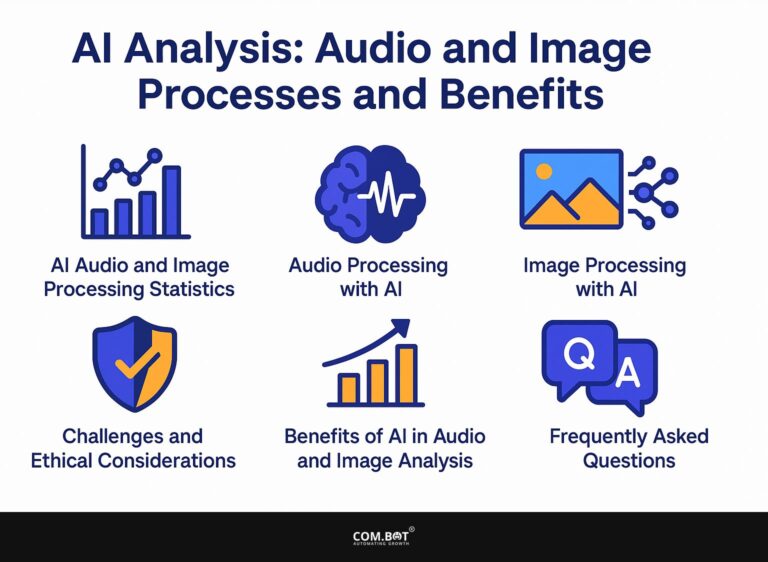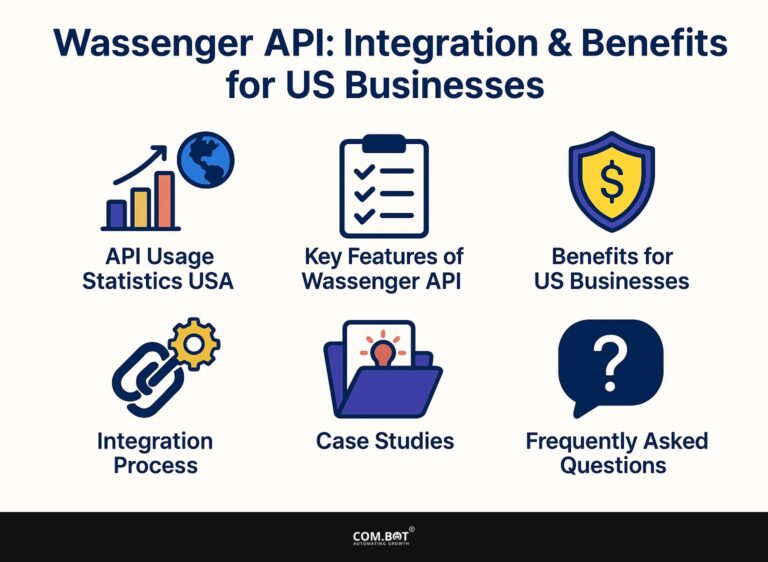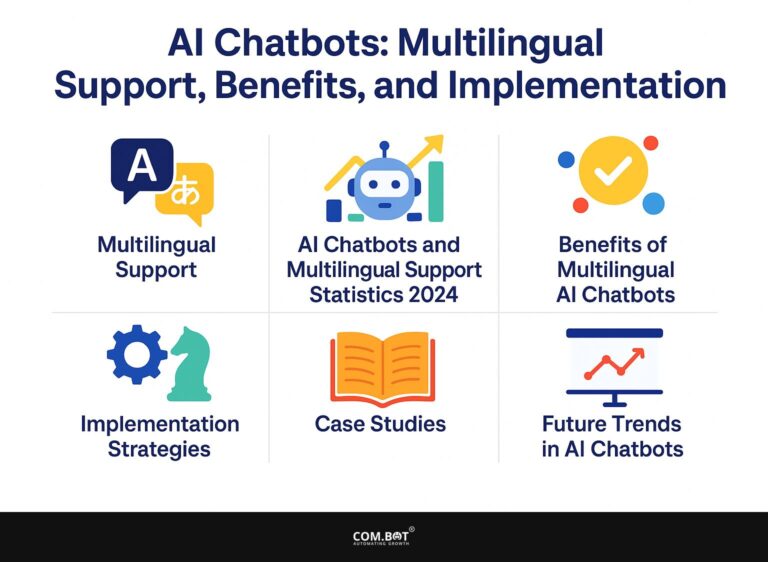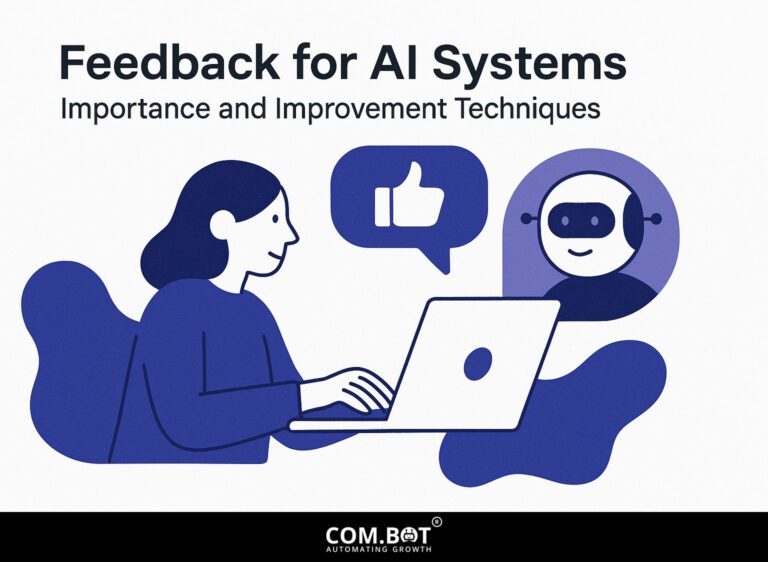Feedback for AI Systems: Importance and Improvement Techniques
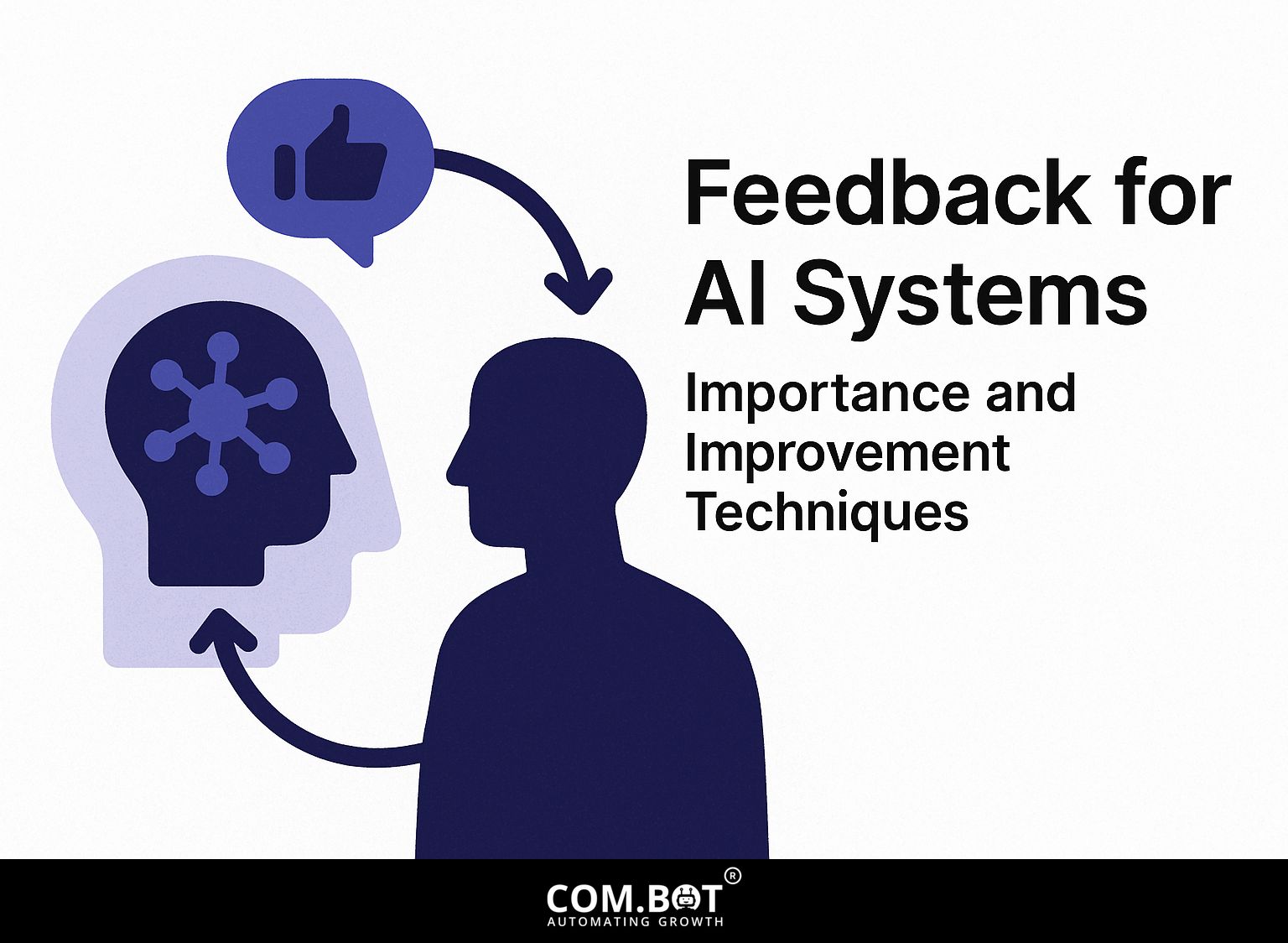
In our rapidly changing digital world, keeping track of and giving feedback on AI systems is important for improving how they work. Organizations using artificial intelligence need to know how important feedback loops are to improve the accuracy and reliability of their AI. This article explores important methods for collecting and using feedback, helping businesses improve their AI systems and build more user trust. Learn how ongoing development can improve your organization’s AI skills.
Key Takeaways:
- 1 Importance of Feedback for AI Systems
- 2 AI Feedback System Statistics
- 3 Types of Feedback Mechanisms
- 4 Techniques for Collecting Feedback
- 5 Implementing Feedback for Improvement
- 6 Challenges in Feedback Implementation
- 7 Future Trends in AI Feedback Systems
- 8 Frequently Asked Questions
- 8.1 What is the importance of feedback for AI systems?
- 8.2 How does feedback improve AI systems?
- 8.3 What are some techniques for providing effective feedback to AI systems?
- 8.4 Why is it important to regularly update feedback for AI systems?
- 8.5 How can AI systems use feedback to make better decisions?
- 8.6 What are the potential consequences of not providing feedback to AI systems?
Definition of Feedback in AI
Feedback in AI consists of the data returned to the system that indicates its accuracy and performance, essential for machine learning and reinforcement learning.
In online shopping, feedback processes can greatly improve recommendation systems. When users give product ratings, this feedback helps improve algorithms like collaborative filtering, which better predicts what users will buy next.
Similarly, in customer support, chatbots learn from interactions. By analyzing feedback on user satisfaction after solving issues, they adjust their responses, improving service.
Tools like Google Analytics can monitor user behavior, giving useful information that helps AI models develop to better meet user needs.
Importance of Feedback Loops
Feedback loops are important in AI systems because they supply ongoing input and adjustment, which greatly improve performance measurements.
For example, Amazon uses feedback loops to improve its recommendation algorithms.
When a user makes a purchase, the system gathers details about their preferences. This helps the algorithm make better recommendations for later purchases.
Similarly, Google uses feedback from user interactions with its search results to improve ranking algorithms, ensuring that the most relevant content appears first.
By regularly studying and changing based on user actions, both companies show how feedback loops support ongoing improvement, resulting in more efficient AI features.
Importance of Feedback for AI Systems
Feedback helps AI systems get better at being accurate and makes users trust them more. It also allows for continuous improvement in how they work, which can be enhanced by implementing effective feedback techniques (our guide on AI feedback improvement techniques explores this further).
AI Feedback System Statistics
AI Feedback System Statistics
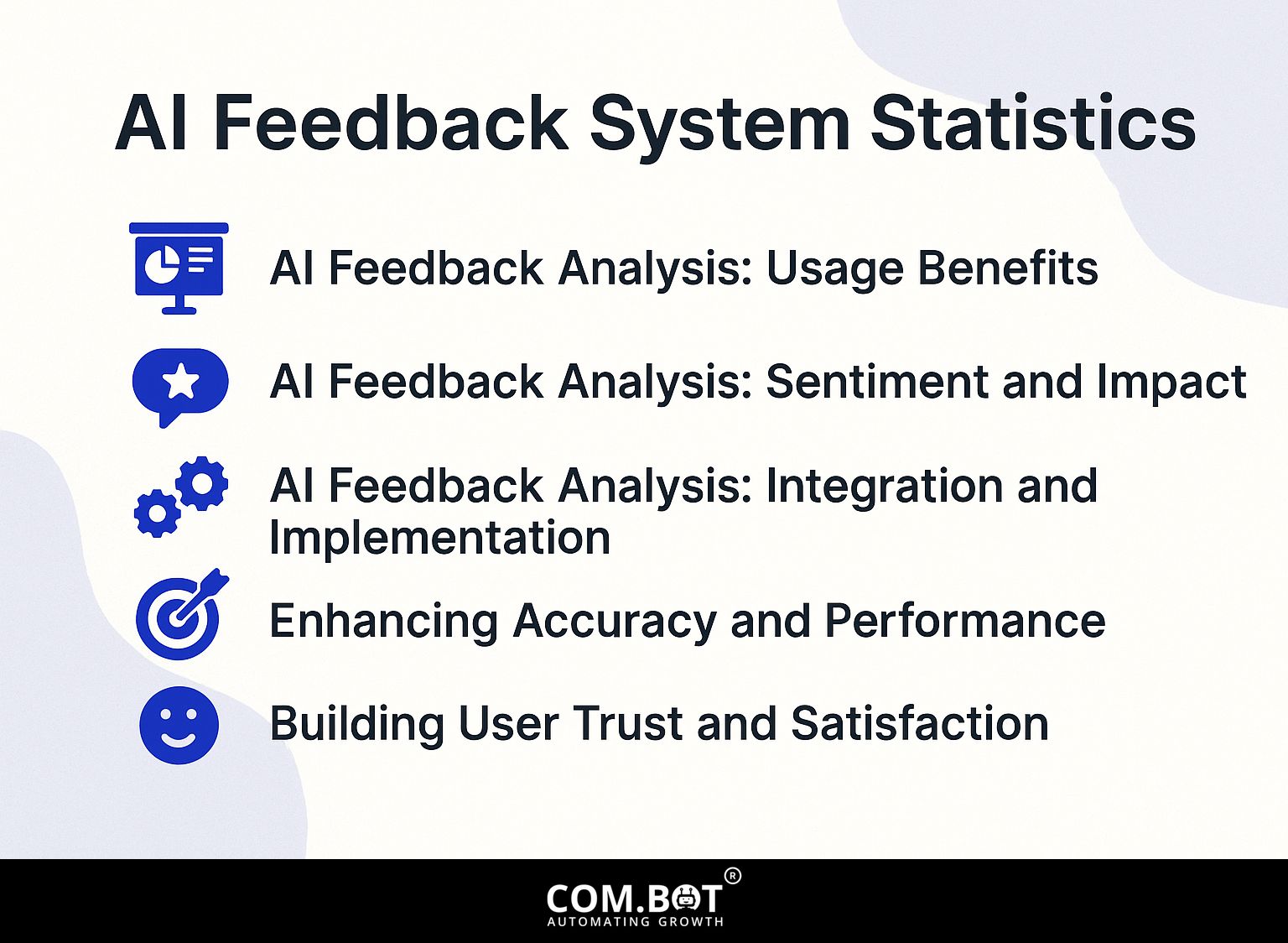
AI Feedback Analysis: Usage Benefits
AI Feedback Analysis: Sentiment and Impact
AI Feedback Analysis: Integration and Implementation
AI Feedback System Statistics Explores the benefits, opinions, and use of AI in feedback systems. The data shows that AI can greatly simplify tasks and increase productivity in different industries.
AI Feedback Analysis reveals significant benefits: 80% of tasks are simplified with AI, highlighting AI’s role in streamlining workflows and reducing manual effort. With 51% of UX researchers using AI tools, there’s a clear trend towards adopting technology for efficient user experience analysis. Moreover, a striking 91% of users are open to expanding AI tools, showing a strong readiness to use AI for better abilities.
- Sentiment and Impact: AI facilitates quick identification of common themes in feedback, cutting review time by 80%. This quickness helps businesses meet customer needs quickly, increasing happiness and commitment. Additionally, with 90% accuracy in multi-language processing AI assists in comprehending and replying to feedback in various languages, which enhances worldwide operations.
Integration and Implementation highlights practical improvements: A 43% productivity boost from AI tools demonstrates their significant impact on performance. AI automation also cuts down the number of meetings by 26%, freeing up time for concentrated task execution. The data also showcases $21,000 saved per person annually, emphasizing the substantial time and cost savings AI integration can offer.
These statistics clearly show how AI is changing feedback systems in a significant way. By streamlining tasks, improving language processing, and increasing productivity, AI is an essential helper in updating operations. The willingness to increase AI tool use suggests a time ahead where AI plays a key role in making strategic choices and improving how things are done.
Enhancing Accuracy and Performance
User feedback can increase AI accuracy by over 30%, which helps systems handle current data more effectively and meet user needs.
To gather and use user feedback effectively, tools like Label Studio can be used for data labeling, enabling users to point out areas for improvement directly in the AI’s output.
Developers can identify areas for improvement by analyzing system performance with metrics such as accuracy and recall. By regularly analyzing this feedback-perhaps through monthly team reviews-AI systems can be retrained, refining their algorithms to deliver more relevant responses.
This method, used many times, makes results more accurate, makes users happier, and gets them more involved.
Building User Trust and Satisfaction
Good feedback systems can increase user happiness by 25%, helping users trust AI technologies and their outcomes.
Feedback systems that actively ask for user thoughts-like surveys, ratings, and comment sections-are very important in keeping users involved.
Platforms like Airbnb send surveys after a stay to gather feedback on user experiences, which helps in making improvements that bring in more users later.
Research indicates that these systems give important information for improvement and help users feel appreciated, strengthening their relationship with the platform.
Tools like UserVoice or Typeform can make it simple to collect feedback, helping to build user trust.
Types of Feedback Mechanisms
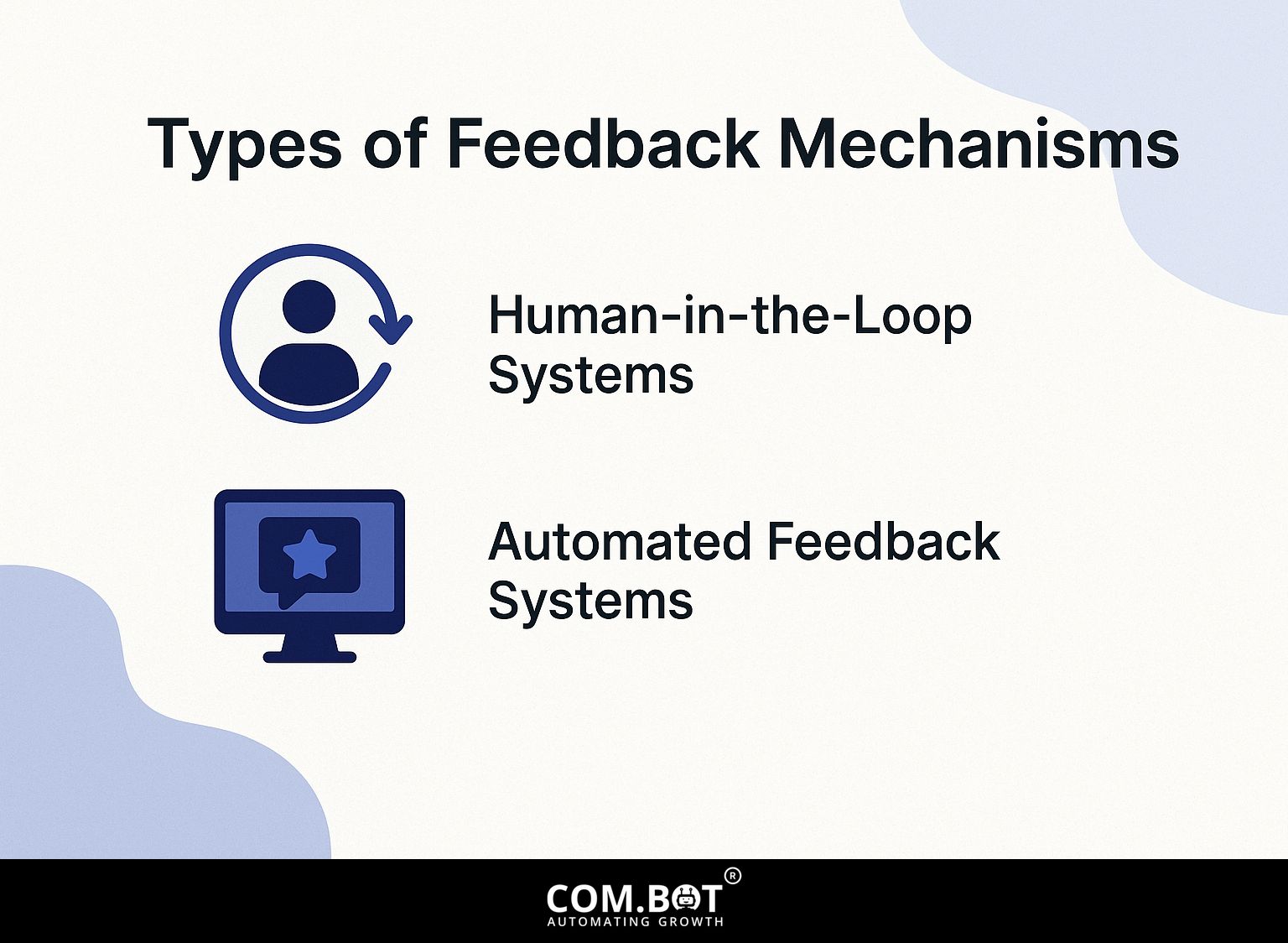
There are various types of feedback methods in AI, each with a specific role and helping make systems work better. For those interested in deeper insights into these mechanisms, exploring different Feedback for AI Systems: Importance and Improvement Techniques can be particularly enlightening.
Human-in-the-Loop Systems
Human-in-the-loop systems use human feedback to improve AI decisions, resulting in high reliability and accuracy.
They are especially useful in healthcare, where difficult choices often need careful judgement.
For example, in radiology, AI algorithms initially flag anomalies in imaging scans. Human radiologists review the results and provide feedback on the AI’s accuracy, which helps improve the algorithm.
Tools like IBM Watson Health use this system to improve cancer diagnosis, blending AI capabilities with human knowledge to reduce errors. This ongoing partnership helps improve patient results and builds confidence in AI technologies among medical professionals.
Automated Feedback Systems
Automated feedback systems use algorithms to collect and analyze user data, enabling quick changes and improvements.
Predictive analytics is important in improving user experiences for e-commerce. These systems use browsing patterns and buying records to suggest products that suit personal likes.
For example, tools like Google Analytics and Hotjar show how users interact with a website. This helps businesses improve their site layout and make the checkout process smoother based on user feedback.
Implementing A/B testing can also help determine the most effective changes, driving higher conversion rates and customer satisfaction. Regularly reviewing these analytics further fine-tunes strategies, solidifying the foundation for a responsive customer experience.
Techniques for Collecting Feedback
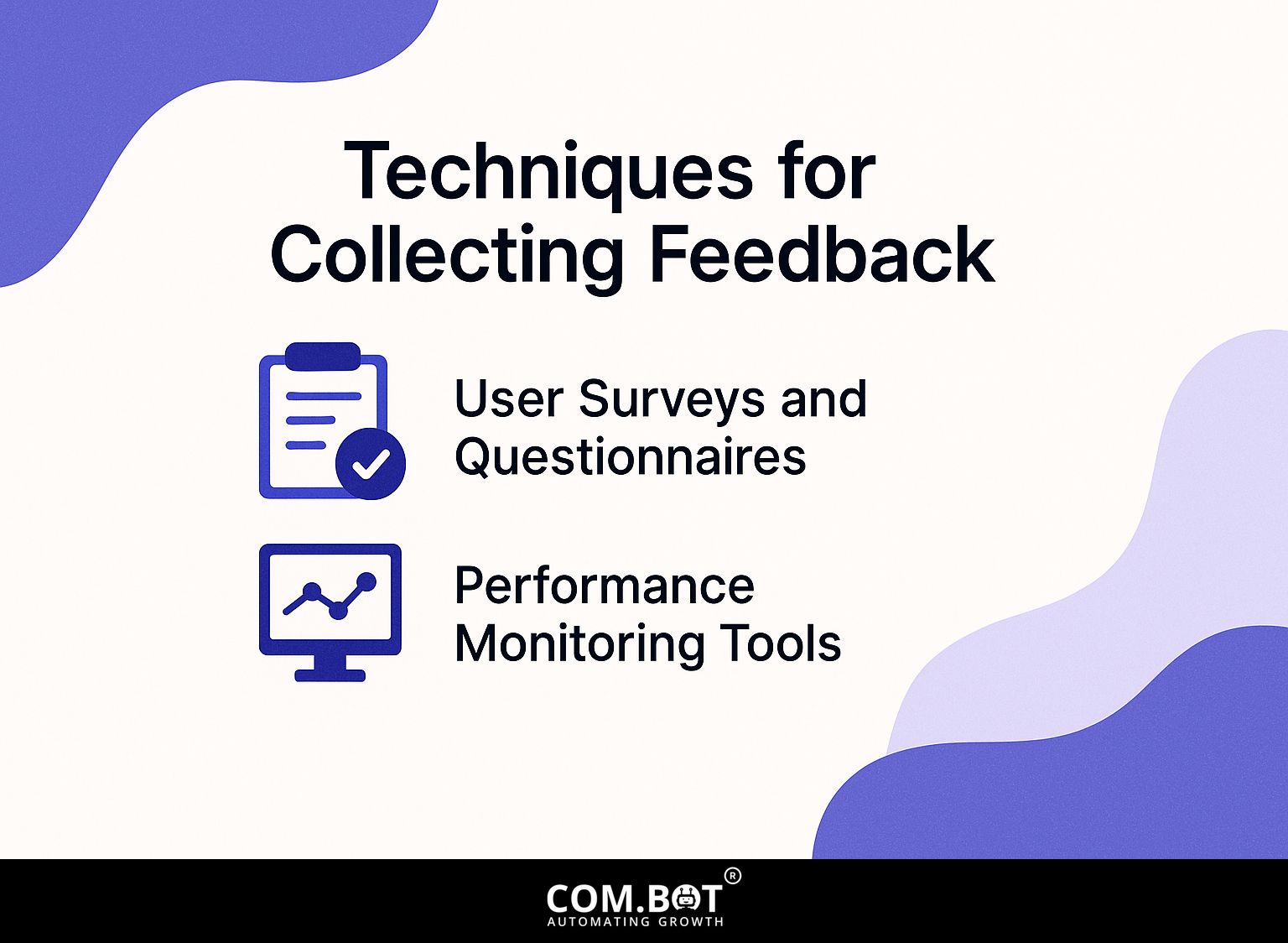
Gathering feedback effectively is key to knowing how well AI systems work and directing needed changes. Implement this by following the methodology in our guide on feedback improvement techniques for AI systems, which outlines essential strategies for collecting and utilizing feedback to enhance AI performance.
User Surveys and Questionnaires
User surveys can provide useful information. Good questionnaires can increase response rates by up to 50%.
To create effective user surveys, start with tools like Google Forms (free) or SurveyMonkey (starting at $25/month).
Focus on clear, concise questions; use a mix of open-ended and multiple choice to gather qualitative and quantitative data. For instance, ask ‘What features do you value most in our product?’ and provide a selection of options.
After gathering replies, use the built-in tools to look at the data or send it to Excel for a more detailed look. Testing your survey before distribution can also help identify any issues with question clarity.
Performance Monitoring Tools
Utilizing performance monitoring tools, such as Google Analytics or Mixpanel, can help track user interactions and system metrics effectively.
For example, Google Analytics provides detailed information about user actions with options such as live tracking and conversion checking, all at no cost.
Mixpanel, starting at $25/month, excels in funnel analysis and cohort segmentation, allowing you to understand user engagement deeply.
Hotjar provides heatmaps and session recordings for around $39/month, helping visualize how users interact with your interface.
Using these tools together helps you create a steady feedback loop to update and improve your AI systems, including ongoing input from users.
Implementing Feedback for Improvement
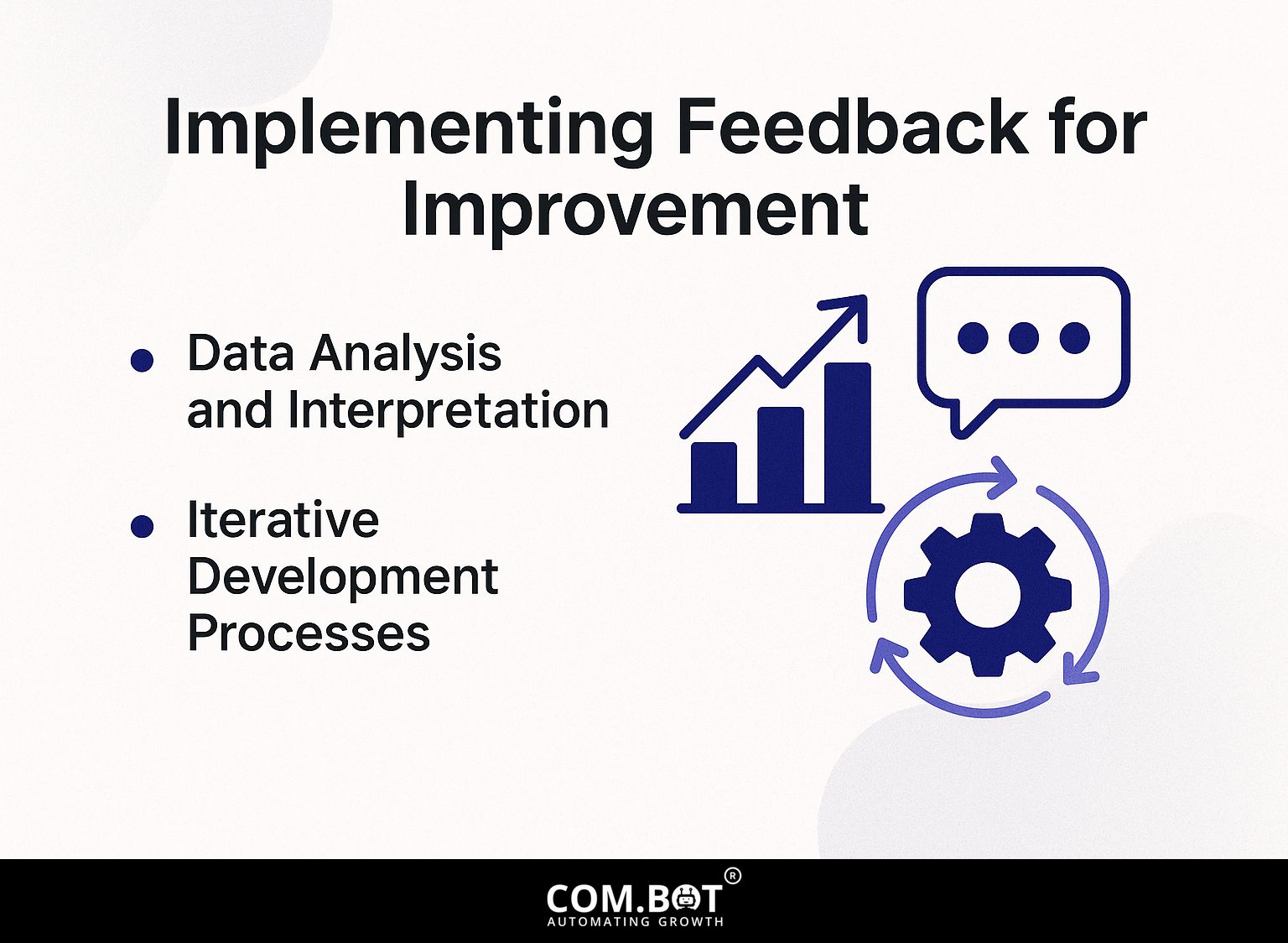
Using feedback effectively is important for continuous improvement in AI systems and fulfilling user requirements.
Data Analysis and Interpretation
Data analysis is important for interpreting user feedback. Tools like Tableau ($70/month) help visualize information to make more informed decisions.
Consider Google Data Studio for free custom reports, or Microsoft Power BI, which offers detailed analytics starting at $9.99/month.
Showing feedback patterns helps teams quickly identify exact areas that need attention. For example, if user ratings are falling for a specific feature, you can look at data by age group or how often it is used to find trends.
Looking at the results every month can greatly improve your AI models, making them better suited to what users want and expect.
Iterative Development Processes
- Step-by-step development allows quick changes in AI systems, using user feedback for ongoing improvements.
-
For example, companies like Google have effectively used user feedback to improve features in their AI-based products, such as Google Assistant. By gathering real-time user data and suggestions, they can quickly roll out updates enhancing functionality.
-
OpenAI uses a similar approach by frequently updating its models based on user feedback to improve how they work. Regular testing, collecting user feedback, and updating the system help AI tools get better, making them more reliable and user-friendly.
Challenges in Feedback Implementation
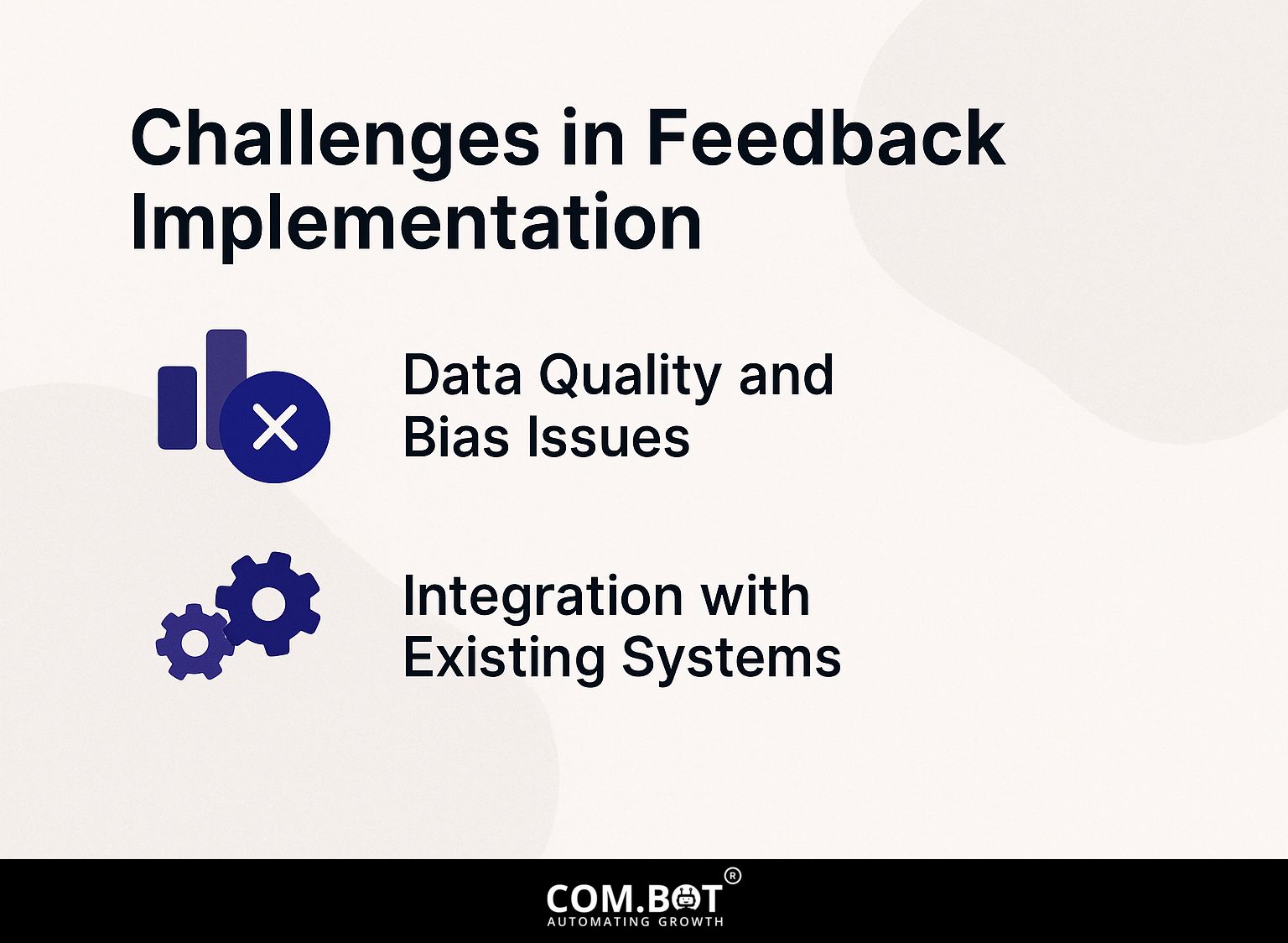
Using feedback systems in AI comes with many difficulties that can affect performance and user satisfaction if not handled correctly. As mentioned in our piece on Feedback for AI Systems: Importance and Improvement Techniques, understanding the importance and development of effective feedback mechanisms is crucial for optimizing AI functionality.
Data Quality and Bias Issues
Issues related to data quality and inherent biases can significantly skew feedback, impacting AI performance and outcomes.
To solve these problems, companies should use strict methods to check data accuracy.
For example, using tools like Talend for data cleansing can help identify inaccuracies before they affect analysis. Employing bias detection algorithms, such as IBM’s AI Fairness 360, allows for the assessment of datasets for hidden biases.
A real-world case is Google, which experienced significant bias in language processing tasks. By integrating these methods, they improved data quality and reduced bias, enhancing their AI model’s performance and ensuring more reliable outcomes.
Integration with Existing Systems
Integrating feedback mechanisms with existing AI systems can be complex, often requiring significant changes to workflows.
To manage this integration effectively, start by identifying the key feedback channels relevant to your AI’s operation, such as user surveys, customer support queues, or usage analytics.
Use tools like Zapier to automatically gather and direct feedback data into your AI system, ensuring information moves smoothly.
Set up regular review sessions where teams look at feedback and make changes to AI models based on real user interactions. This keeps the system current and responsive to users.
This repeated method can greatly improve results over time.
Future Trends in AI Feedback Systems
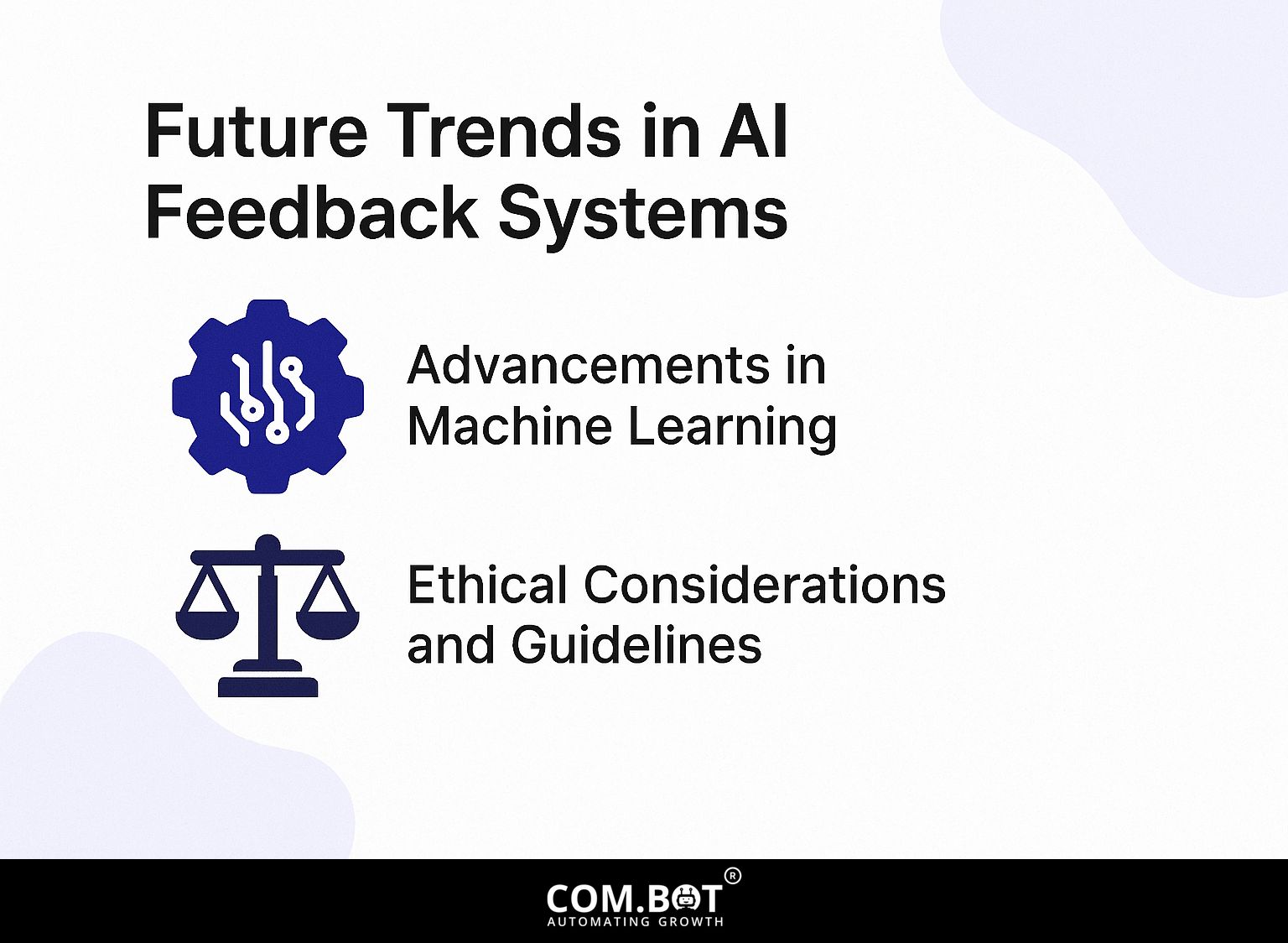
Upcoming developments in AI feedback systems bring advancements, especially in machine learning and ethical issues. For a deeper understanding, consider how Meta AI’s tools and limitations play a pivotal role in shaping these systems, addressing challenges in content moderation and ethical AI.
Advancements in Machine Learning
Recent advancements in machine learning are enhancing the capabilities of feedback systems, allowing for increasingly sophisticated predictive analytics.
For example, companies such as Amazon and Netflix are using improved feedback systems to make their recommendation engines better. These systems can forecast what users like very well by looking at how users interact and how well they perform.
Machine learning tools like TensorFlow and PyTorch help developers make immediate changes based on user feedback. Industries like healthcare are utilizing this technology by integrating patient feedback into predictive models, improving treatment efficacy.
These examples demonstrate how repeated learning methods are altering decision-making in various fields.
Ethical Considerations and Guidelines
As feedback systems become more prevalent, ethical considerations surrounding data use and user privacy are paramount.
Organizations should prioritize transparency and user trust by adopting clear guidelines for feedback collection. Tell users clearly how their data will be used and make sure you get their consent.
Next, anonymize feedback to protect identities by using combined data instead of personal answers. Put strong security measures in place to stop unauthorized access by using tools such as encryption and regular audits.
Discuss with users about their experiences to collect thoughts on the feedback system, allowing for the creation of a loop that fosters a reliable atmosphere.
Frequently Asked Questions
What is the importance of feedback for AI systems?
Feedback helps AI systems learn and get better at what they do over time. Without feedback, AI systems wouldn’t be able to adjust to new situations and make correct choices.
How does feedback improve AI systems?
Feedback helps AI systems identify and correct errors, improve accuracy, and increase efficiency. It helps them to learn from past events and make smarter choices later on.
What are some techniques for providing effective feedback to AI systems?
Some techniques for providing effective feedback to AI systems include providing specific and detailed information, using a combination of positive and negative feedback, and giving feedback in real-time.
Why is it important to regularly update feedback for AI systems?
Regularly refreshing feedback for AI systems makes sure they learn from the latest information and circumstances. It helps them adjust to changes and keep getting better at what they do.
How can AI systems use feedback to make better decisions?
AI systems use feedback to analyze and evaluate their past decisions, identify patterns and trends, and make adjustments accordingly. This helps them make better choices later.
What are the potential consequences of not providing feedback to AI systems?
AI systems need feedback; otherwise, they might repeat mistakes and wrong choices, causing incorrect results and possible damage to people or businesses. It might also limit their ability to change and grow over time.
